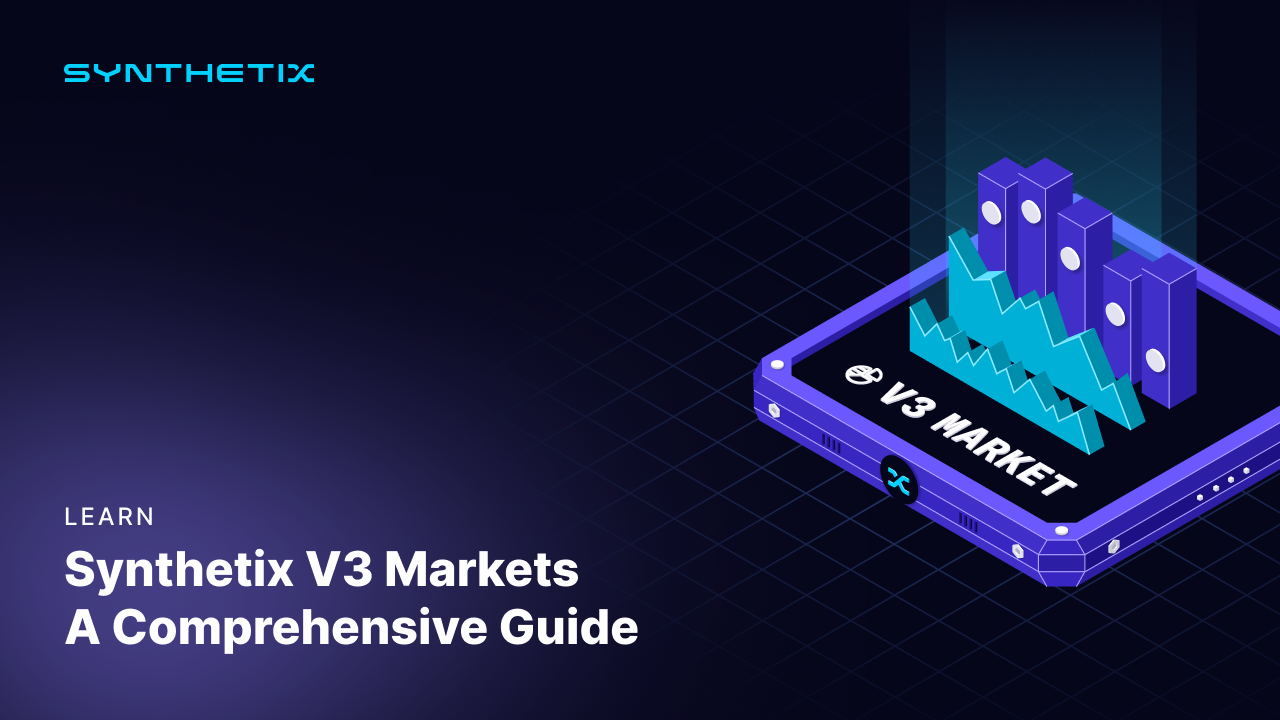Synthetix V3 Markets: A Comprehensive Guide
Synthetix V3 brings a groundbreaking approach to creating onchain derivatives and financial products, with markets at its core. These markets draw from liquidity pools, fueled by liquidity providers (LPs) who delegate collateral and stablecoin liquidity.

Introduction
Synthetix V3 brings a groundbreaking approach to creating onchain derivatives and financial products, with markets at its core. These markets draw from liquidity pools, fueled by liquidity providers (LPs) who delegate collateral to pools, which is then used to generate liquidity for derivative markets. Let's unpack how this dynamic system operates.
The Role of Markets in Synthetix V3
Markets are the backbone for creating various onchain financial products, from spot markets and perpetual futures to options, insurance, and many more. These markets tap into pools, which amass collateral delegated by individual LP's and then generate sUSD against this collateral to facilitate seamless derivatives trading.
For instance, consider Synthetix Perps. It requires deep liquidity, originating from LPs (aka stakers in V2x). The Synthetix Spartan Council allocates this liquidity, determining parameters like open interest limits, fees, and other important variables. When trades occur, LPs momentarily counterbalance the trade, only until another trader, driven by risk-balancing incentives, steps in to balance the market skew back to neutral.
Efficiently designed markets, such as the Perps market, incorporate risk management tools like dynamic funding rates and price impact mechanisms to transiently expose LPs to risk and maintain equilibrium. Fees generated from trades and liquidations are distributed to stakers. And while Synthetix Perps isn't V3-native yet, the collateral flow and fee distribution principle remains consistent.
Before we dive deeper, it's crucial to grasp the broader framework of V3. We'll explore vaults, pools, and delve deeper into markets subsequently.
But before all of that, let's take in a graphic that displays the entire flow of fees and liquidity throughout all pieces of the system.
Alright, back into the details.
Vaults
In the V3 iteration, users deposit governance-approved collateral into vaults to generate sUSD, the Synthetix ecosystem stablecoin. Drawing parallels, a V3 vault resembles MakerDAO's and Liquity's collateralized debt positions (CDP). Synthetix, however, enables CDP owners to delegate collateral to pools, helping to fuel derivative markets for traders.
Pools
LPs delegate their collateral to pools, which act as pooled CDPs, providing liquidity to markets and enabling developers to generate liquidity for onchain financial products. These markets then generate fees, benefitting LPs. Pool owners govern the liquidity distribution to markets. For instance, the Spartan Council Pool would use governance SCCPs to decide liquidity distribution across markets.
Markets
V3's markets, with liquidity from pools, facilitate the creation of onchain derivatives. Once delegated liquidity, markets can access sUSD, fostering a liquid environment for trading. By participating in well-designed markets with suitable fee structures, liquidity providers can earn trading fees.
Example Markets: Perpetual Futures (like Synthetix Perps), Options (like Lyra), Spot (like Spot Synths), Insurance, Lottery (like Pool Together), etc.
Incentives for Liquidity Providers:
By delegating collateral to well-designed markets with appropriate fee structures, liquidity providers can generate trading fees. Ideally, this incentive encourages more liquidity providers to participate in the market, ultimately enhancing the overall liquidity of the Synthetix V3 ecosystem.
Walkthrough: Creating a Perpetual Futures Market with Synthetix V3
Synthetix V3 can seamlessly create a perpetual futures market. Here's the step-by-step process:
- Collateral Deposit by Stakers: LPs deposit collateral, ex: SNX/ETH/USDC, into a V3 vault. This allows them to delegate to the Spartan Council Pool, which in turn delegates sUSD liquidity generated against this collateral to the perpetual futures market.
- Stablecoin Withdrawal by Perpetual Futures Market: The market accesses stablecoins from the pool (via the LP) to facilitate trading.
- Trading Fee Implementation: Each open or closed position incurs fees, which flow back through the market and pool to be distributed pro rata to LPs.
- Incentivizing LPs: As trading occurs, fees accrue. These fees are channeled back to LP's pro rata.
Alternatively, it may be easier to understand this system by taking a step back and viewing it from start to finish.
Going Deeper
Learn more about Synthetix V3 by visiting the following links:
- Synthetix V3 Development Progress
- Where Synthetix V3 could take us - CC Cavalier
- Getting to the Synthetix v3 End Game - CC Cavalier
- $500m is waiting for you to #BuildOnSynthetix - CC Cavalier
- Synthetix V3 is on Mainnet - CC Noah
- Perps V3 Testnet Competition
- A fork in the road. - Kain Warwick
- A quick explainer on Synthetix V3 - CC Matt

